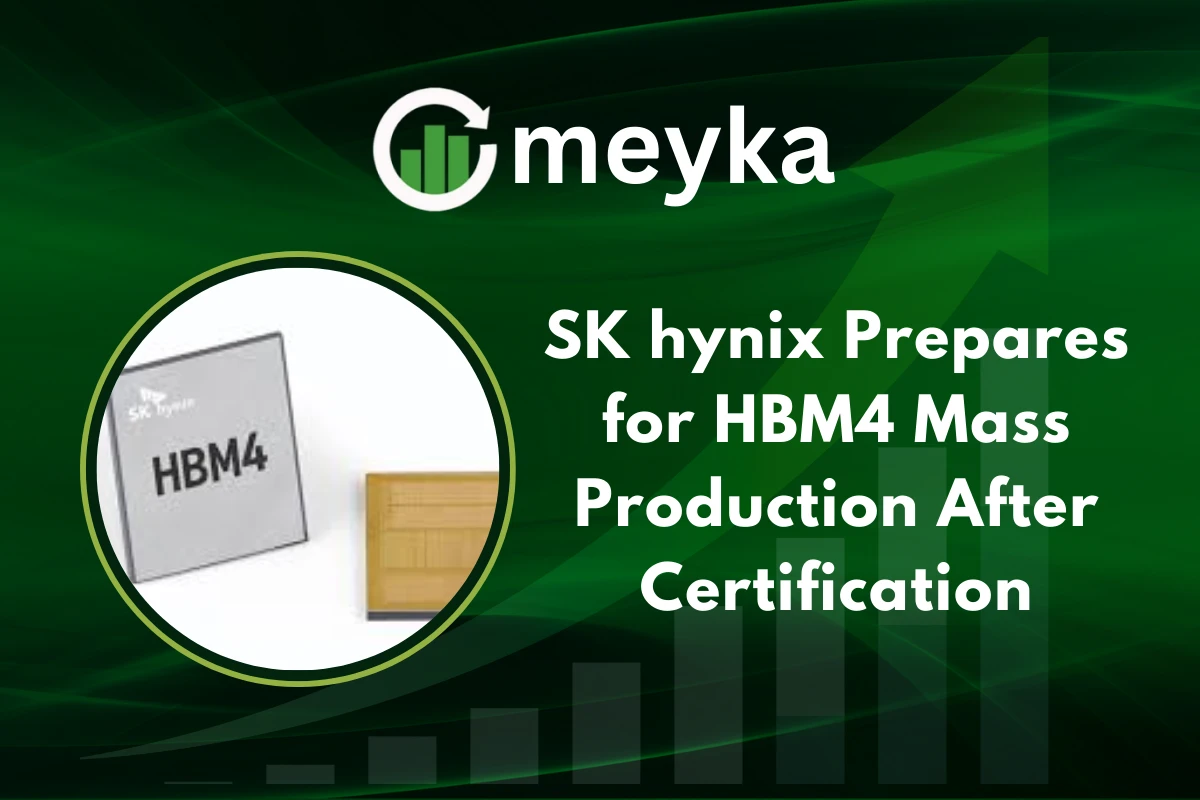SK hynix Prepares for HBM4 Mass Production After Certification
SK hynix confirmed it has completed internal certification of HBM4 memory and is preparing to begin mass production. The company says it shipped 12-layer HBM4 samples in 2025 and completed customer testing. This milestone is critical for AI models, hyperscale data centers, and high-performance computing applications that rely on high memory bandwidth for real-time processing and richer analytics.
SK hynix and the rise of HBM4 chips
HBM4 raises sustained bandwidth and improves energy efficiency by stacking DRAM dies and using advanced packaging. SK hynix states HBM4 doubles bandwidth and improves power efficiency by about 40% versus prior generations.
That boost speeds image analysis, AI inference, and large-scale data processing. Faster memory supports cloud computing, AI model training, and real-time analytics in data centers across Seoul, New York, and London.
SK hynix: Why mass production is happening now
Demand for high-bandwidth memory has surged with generative AI, edge computing, and cloud expansion. SK hynix shipped 12-layer HBM4 samples in March 2025, and internal certification clears the path for volume shipments later this year.
The company is moving early to secure orders from GPU partners and hyperscalers ahead of rivals such as Samsung and Micron. Analysts say yields, pricing, and competitor ramps will ultimately shape long-term market share.
SK hynix: How HBM4 chips support AI and cloud platforms
HBM4 raises channel counts and I/O capacity, allowing GPUs to access larger datasets faster. Cloud and edge operators can place heavier AI and data models closer to users, cutting latency for inference tasks.
This translates into faster processing for large-scale AI applications, lower-latency computations, and richer real-time analytics for data centers in metros like Bangalore, Sydney, and Berlin. Lower energy per inference also reduces operational costs.
SK hynix: Market response to HBM4 certification
Markets reacted quickly when SK hynix announced HBM4 readiness. Shares rose as investors priced in stronger HBM demand and AI memory revenue. Reuters and Bloomberg quoted analysts who expect SK hynix to maintain a strong HBM share into 2026 if early HBM4 supply and customer qualification hold.
Observers say yields and pricing will determine adoption speed. Nvidia’s earlier requests to accelerate HBM4 supply underscore urgency from GPU partners.
SK hynix: Global impact of HBM4 on AI and cloud services
HBM4 changes how data centers plan rack density, cooling, and power delivery. Higher throughput per rack allows operators to run larger models without matching increases in energy. This enables AI platforms and cloud services to refresh models more frequently and add richer features without huge cost increases.
SK hynix also adopted Advanced MR-MUF packaging to support 36GB capacity in a 12-layer stack. That packaging improves heat dissipation and mechanical stability for dense GPU racks. More operators in major markets will evaluate HBM4 for dense GPU deployments.
SK hynix: Future of semiconductors and AI integration
SK hynix highlights packaging and process improvements to reduce warpage and improve thermal performance. As mass production begins, systems teams must validate firmware, thermal profiles, signal integrity, and interoperability.
Enterprises should run pilots, stage latency-sensitive features, and maintain multi-supplier sourcing to reduce supply risk while yields stabilize. Close hardware-software co-design among memory makers, GPU vendors, and cloud operators will be essential to unlock full performance and reliability.
Why is SK hynix pushing HBM4 chips after certification?
Internal certification verifies performance and interoperability. That clearance lets SK hynix schedule volume shipments and helps GPU and cloud partners finalize system builds with confidence.
How does HBM4 benefit AI and cloud platforms?
HBM4 shortens inference time, raises sustained throughput, and lowers energy per operation. That enables faster AI model training, improved real-time analytics, and higher throughput for large-scale computing applications.
What does this mean for AI data centers worldwide?
Data centers gain denser memory per GPU, higher throughput per rack, and improved energy efficiency. This supports larger models, lower latency, and more responsive services across major metros.
Social and analyst reactions
Real-time social posts added color to the announcement. Analyst Ray Wang tweeted: “BIG: SK Hynix completed HBM4 development; mass production ready.”
Market monitor Wall St Engine tweeted: “SK Hynix began HBM4 supply in June; competitor testing ongoing.”
These posts helped investors and engineers parse timing and sentiment during the rollout.
Practical steps for platform and ops teams
Teams deploying AI and cloud platforms should begin pilot testing HBM4 modules now. Validate thermal behavior, firmware, and power envelopes in representative racks. Run end-to-end tests for inference latency and model accuracy under real loads.
Stage latency-sensitive features, maintain fallback paths, and consider multi-supplier sourcing while yields and pricing stabilize. These steps help teams deploy latency-sensitive features safely while managing vendor risk.
Conclusion
SK hynix’s completion of internal HBM4 certification and readiness for mass production is an important milestone for AI memory. Platforms and cloud operators will benefit from faster inference, better energy efficiency, and richer real-time services.
Pilots and staged rollouts are expected in Korea, the US, Europe, and India as customers validate performance. If yields, pricing, and integration proceed as planned, HBM4 could reshape the global memory market and accelerate the next wave of AI-driven applications.
FAQ’S
SK hynix HBM4 is the latest high-bandwidth memory (HBM) technology designed for AI, cloud computing, and high-performance data centers. It offers double the bandwidth and 40% better power efficiency than previous generations, enabling faster AI processing and real-time analytics.
After completing internal certification in 2025, SK hynix plans to begin mass production of HBM4 chips later this year, targeting GPU partners, cloud operators, and hyperscale data centers globally.
SK hynix HBM4 reduces inference latency, increases throughput, and lowers energy per operation. This enables faster AI computations, better data processing, and improved efficiency for cloud platforms and AI-powered applications.
Major markets including Korea, the United States, Europe, and India will benefit from SK hynix HBM4 memory, particularly for AI data centers, hyperscale cloud operators, and enterprise computing applications.
SK hynix competes with Samsung and Micron in the HBM market. Its early HBM4 certification and readiness for mass production position it to capture significant market share in AI and cloud memory solutions.
Disclaimer
This is for information only, not financial advice. Always do your research.






